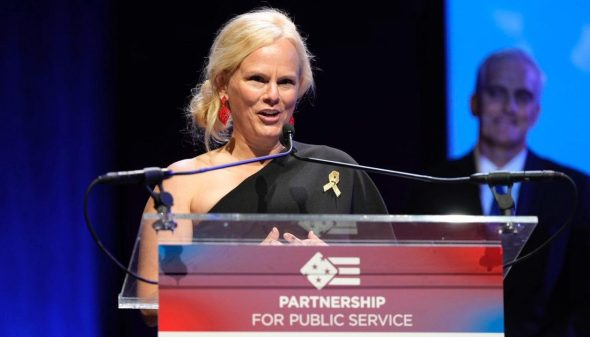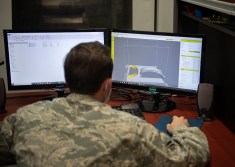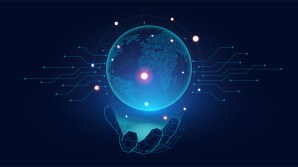An interview with Sammies emerging leader award winner Callie Higgins

National Institute of Standards and Technology scientist Callie Higgins last night won the emerging leaders award at the 2021 Samuel J. Heyman Service to America Medals awards, known as the Sammies, which are hosted annually by the Partnership for Public Service.
The 31-year-old received the accolade for inventing a technique to identify microscopic flaws that emerge during 3D printing. The work focuses on the printing of material that can be used in regenerative medicine and will potentially be used to print replacement organs such as synthetic lungs.
Higgins worked with her team to develop a hybrid atomic force microscope-3D printer — the first such device in the world — which allows products to be evaluated at the sub-micrometer level, instead of conventional millimeter length scales.
Auto manufacturer Ford Co. is among the private sector companies that have taken an interest in the work of the 31-year-old materials research engineer.
FedScoop spoke with Higgins after winning her award to learn more about her work, the potential 3D printing hold and what’s next for her research.
Editor’s note: This interview has been edited for clarity and length.
FedScoop: How did you come up with the idea for your invention?
Callie Higgins: I was finishing up my Ph.D. at the University of Colorado at Boulder with my awesome research team, and we were studying 3D printed hydrogels — these materials that you could use as synthetic tissue — and I started collaborating with researchers at the National Institute of Standards and Technology (NIST.)
I think what we realized is that, OK, we have been tackling this from the perspective of just tissue engineering in my Ph.D., but NIST has these incredible capabilities and these wild metrology tools, so we thought: Why don’t we go down to the fundamentals and try and transform the whole industry? This was really the seed that got it started.
FS: When people think about 3D printing, they perhaps think about printing knick-knacks and prototypes. Could you give us a flavor of what work is going on within federal agencies?
CH: Sure. Specifically in my field and the work we’re pushing forward is focused on tissue engineering and regenerative medicine. The type of printing that I do, which is this photopolymer manufacturing, is very unique in terms of 3D printing in general. You can build up structures at the molecular level.
You can build up very local mechanical and chemical properties that are required for cells to turn into the kind of tissue that you want. We’re working on developing with companies and different stakeholders different types of synthetic tissue. For example, we’re working with 3D Systems and United Therapeutics to build a synthetic lung.
If someone asked me five years ago, honestly, if we’d be closer to printing organs, I would have said: “OK, maybe we are like 20 or 30 years down the road. That sounds wonderful, kind of fantastic, and we could get there at some point.” Now because these stakeholders and industry partners are really recognizing the value of the technology, they are putting in so much R&D effort and investing in us as researchers, national labs and academia, we are accelerating the pace of development. We are building synthetic lung tissue. It’s just unbelievable.
FS: Ford Motor Co. has taken an interest in your work. How have you found navigating partnerships with private industry?
CH: I feel so fortunate that I’m at NIST because we are under the Department of Commerce, which means that we exist exclusively to serve U.S. commerce. Our mission is to drive innovation in commerce through technology development, standards development and fundamental research in general, so we are encouraged to interact with industry.
What’s nice about it is that we have no skin in the game — we’re not here to make a profit. We’re independently funded by Congress, so people can talk openly with us. So we can really drive change without feeling like we are competing with them, because we are not. We’re just here to drive innovation through our research.
FS: Finally: What is it like working at NIST?
CH: It’s a dream. It’s funny because in graduate school I was working with materials that react to light. You often had to be in a dark lab, and often I was all by myself, so I wasn’t sure if I wanted to do research after graduate school. I came to NIST, and it was such a different environment; it was so collaborative, so encouraging, and so supportive of the work I wanted to do. It’s amazing when you have a team of people that are all reaching toward a certain specific goal, and you are all experts in your field. It’s been a dream come true and I hope to never leave.




